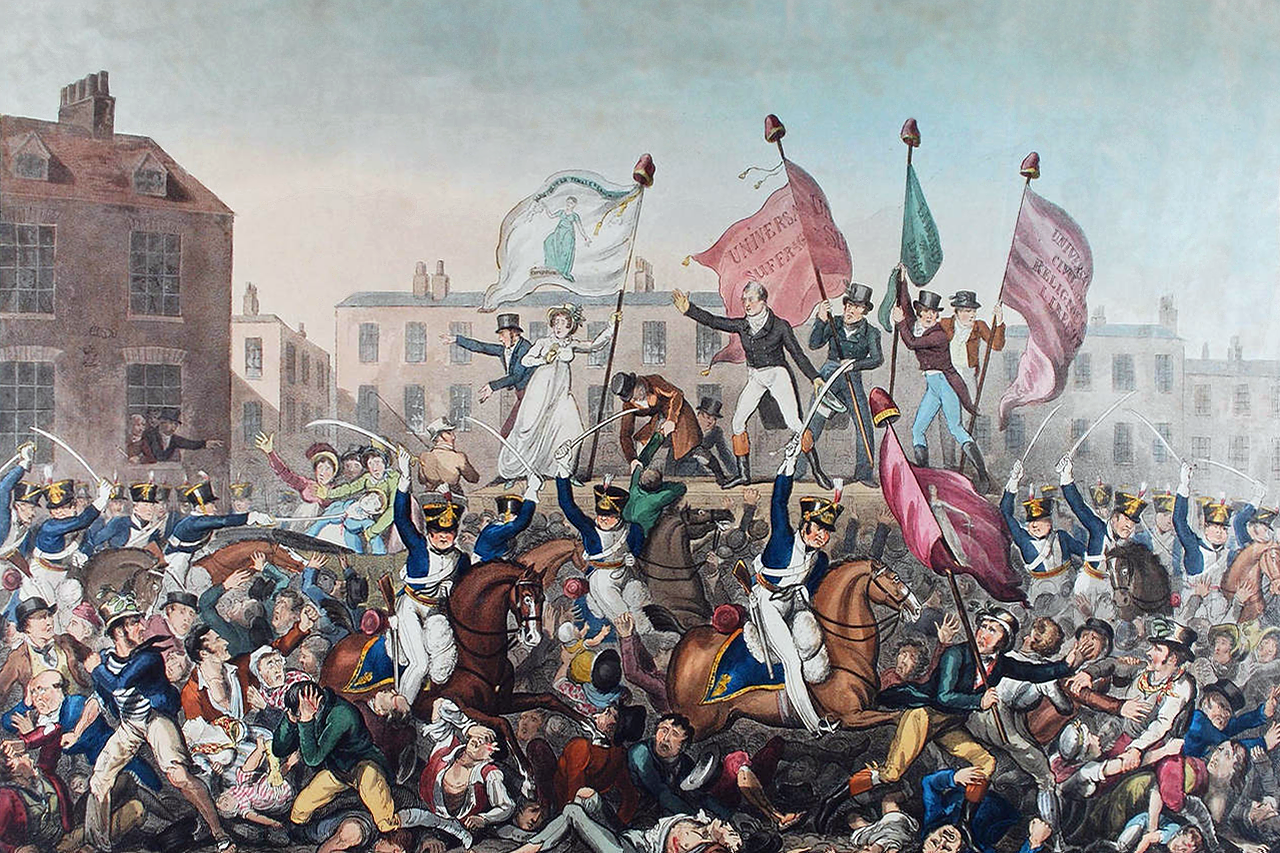 In spite of victory, the Napoleonic Wars left Britain with chronic economic problems. The Government's response, the Corn Laws, resulted in famine and unemployment, which only served to politicise the poorer echelons of society who joined with the political radicals of the middle classes to demand parliamentary reform. Radicals formed organisations to promote their cause, with many being formed in the growing industrial towns in the English midland and northern counties, which were relatively poorly represented in the House of Commons.
In spite of victory, the Napoleonic Wars left Britain with chronic economic problems. The Government's response, the Corn Laws, resulted in famine and unemployment, which only served to politicise the poorer echelons of society who joined with the political radicals of the middle classes to demand parliamentary reform. Radicals formed organisations to promote their cause, with many being formed in the growing industrial towns in the English midland and northern counties, which were relatively poorly represented in the House of Commons.
In March 1819, a group of Lancashire radicals formed the Manchester Patriotic Union Society to call for reform of Parliament. In the summer of that year, the leaders of the society organised a public meeting for the whole of the county at St. Peter's Fields. They invited some of Britain's leading radical speakers including Major Cartwright, Henry 'Orator' Hunt and Richard Carlile, to make speeches to what they hoped would be the largest assembly ever seen in their county.
Fearing that the meeting might develop into a riot, the local magistrates arranged for around 1500 soldiers to be deployed in Manchester on the day of the meeting, 16th August 1819. Before the meeting, the magistrates gathered in Mr Buxton's house, which overlooked the field, where they became increasingly nervous as the crowd grew - one magistrate estimating that 50,000 people had arrived by midday. The magistrates ordered the special constables to clear a path between their Mr Buxton's house and the stage should they need to disperse the crowd.
When the invited radicals started to speak, at around 1.30pm, the magistrates decided that "the town was in great danger" and ordered the constables to arrest the speakers. The deputy constable, Joseph Nadin, replied that he needed military aid to do so. The chairman of the magistrates, William Hulton, wrote two letters instructing the military commanders to assist the constables.
The Manchester and Salford Yeomanry entered the field on horseback, and began to ride along the path cleared by the constables. Seeing what was intended, members of the crowd linked arms to prevent the soldiers reaching the stage and closed the pathway. In response, some of the yeomanry began to slash at the crowd with their sabres to force their way to the hustings, where they arrested not only the speakers and the organisers, but also the newspaper reporters who had gathered there. Fearing that the crowd was attacking the yeomanry, Hulton then sent in the 15th Hussars to rescue the yeomanry by clearing the crowd. By 2pm the soldiers had cleared most people from the field where eighteen people died and around five-hundred suffered injury, inlcuding about one-hundred women.
The actions of the magistrates and miltary commanders disgusted moderate reformers in Manchester and beyond as reports of the massacre (now called 'Peterloo', a reference to the battle of Waterloo) appeared in the press. Conversly, the government responded by congratulating the magistrates and passed legislation to prevent mass-meetings from taking place again. The organisers and speakers faced trial in March of the following year: four men were found guilty and sentenced to between one and two-and-half years in prison; four others were acquitted.
To learn more about Peterloo and the radical reform movement see the recollections of one of those arrested at the meeting: Samuel Bamford's Passages in the Life of a Radical (1893) at gerald-massey.org.uk.
Customised search for historical information
16 August 2008
On this day in history: Peterloo Massacre, 1819
Subscribe to:
Post Comments (Atom)















2 comments:
GREAT BLOG.I'd like to gert more ads like yours and also more style like yours can you help.G
Thanks for the kind words.
I have left comments on a couple of your blogs in response to your query.
Here is what I said...
I received your comment on Modern Historian.
For ads I use Project Wonderful and adsense.
In order to attract advertisers I have used entrecard to increase the number of hits I receive. Simply set up an account, and then start clicking on the entrecards on other blogs to receive credits that you can use to advertise your own blogs.
As for style, I made my own template. This required quite a bit of work. If you do not wish to learn xml and spend time fiddling with the template then there are lots of web-sites that offer blogger templates for download.
I hope this answers your question.
Post a Comment